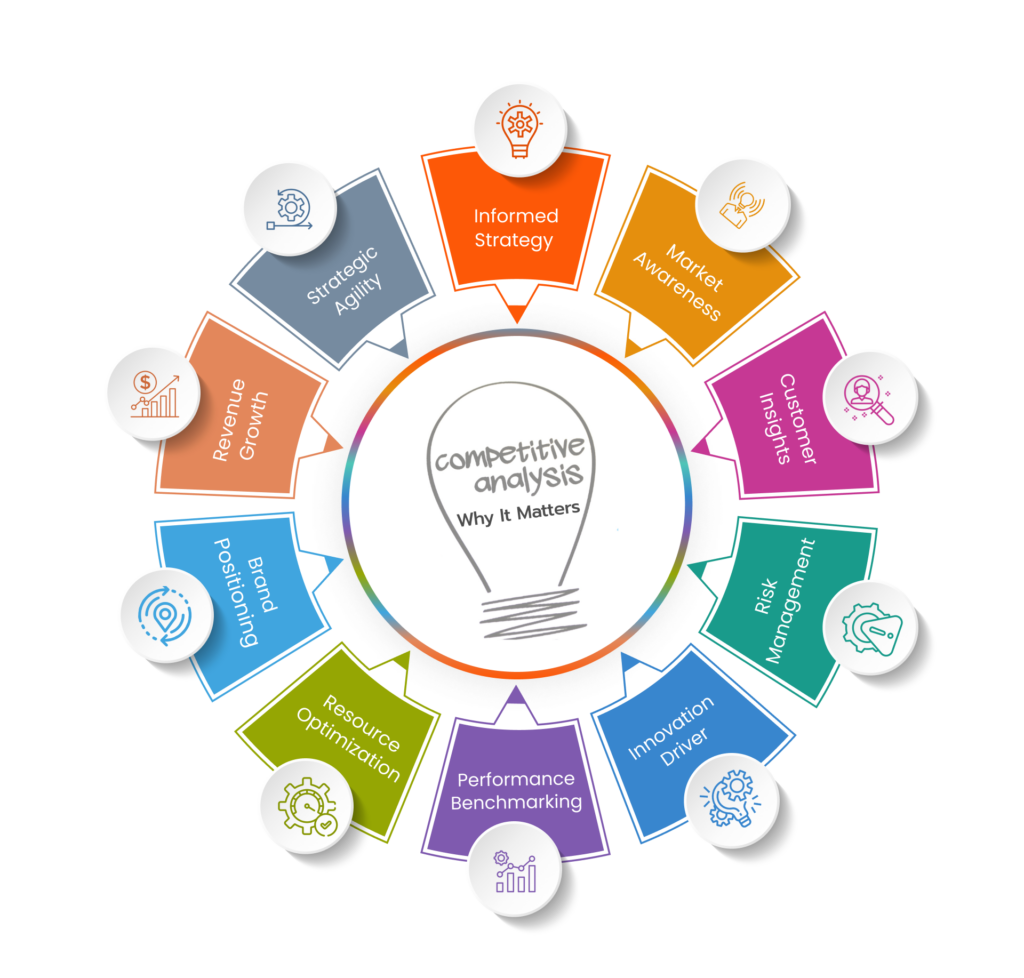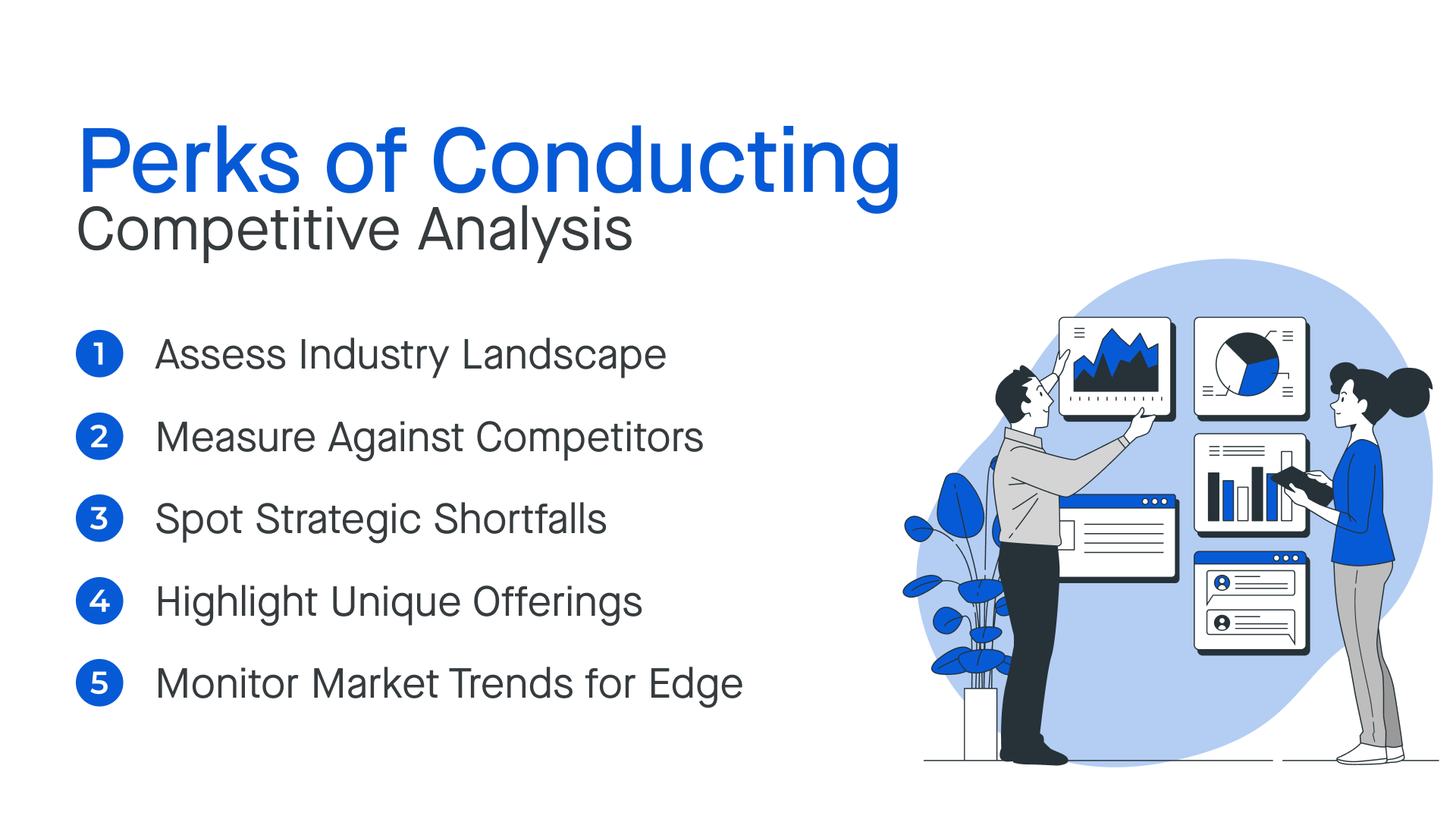


As they say, knowledge is power. So it goes for today’s fiercely competitive business landscape, where staying ahead of the curve requires more than just a great product or service.
The ability to peek over the fence and understand what your competitors are up to can be the difference between thriving and merely surviving.
That is exactly where competitive analysis comes into play—a strategic Sherlock Holmes adventure that uncovers the secrets of your rivals and turns them into actionable insights.
With the global market for competitive intelligence tools projected to soar to billions in the coming years, it’s clear that businesses are investing heavily in this area.
So, in this article, we’ll delve into what competitive analysis is, why it’s crucial for businesses, and how you can conduct it effectively to gain a competitive edge.
Imagine you’re a detective in the bustling market of Businessville. Your mission, should you choose to accept it, is to uncover the secrets of your rivals. This mission, known as Competitive Analysis, is a thrilling adventure into the strengths, weaknesses, strategies, and tactics of your competitors.

It’s like having a magnifying glass that reveals the hidden moves on the business chessboard. It is all about understanding the battlefield and using your unique strengths to capture the flag of success. It involves a mix of artistic intuition and scientific data analysis, blending creativity with strategic thinking.
In simpler words, competitive analysis is the process of identifying and evaluating your competitors to understand their strengths and weaknesses relative to your own business or product.
This strategic approach helps businesses gain a deeper understanding of the market landscape, make informed decisions, and develop effective strategies to stay ahead of the competition.

Imagine you run a small coffee shop and want to conduct a competitive analysis. You identify three direct competitors in your area: A popular chain cafe, a local artisanal coffee shop, and a nearby bakery that also sells coffee.
Based on this analysis, you might decide to differentiate your coffee shop by offering a blend of high-quality coffee, cozy ambiance, and reasonable prices, addressing the weaknesses of your competitors while emphasizing your strengths.
Remember, competitive analysis is not a one-time quest but an ongoing saga. Keep your detective hat on and your magnifying glass polished. The market is ever-changing, and so are the secrets it holds.
Let’s consider another fun example to make competitive analysis easier to understand.
Imagine “Cupcake Central,” a small bakery in the heart of “Business Ville”, which is up against “Muffin Mountain,” a rival bakery.
Cupcake Central’s “Berry Bonanza” becomes a hit! The quick service and flavor-packed cupcakes steal the show, and customers start flocking. Muffin Mountain’s sales dip, and they scramble to respond.
Competitive analysis is crucial for businesses of all sizes and industries. In the grand chess game of business, competitive analysis is the master move that can give a company the upper hand it needs.
Here’s why it should be an indispensable part of your business strategy:

Embarking on a competitive analysis begins with the pivotal task of mapping out the competitive terrain. This initial phase is crucial as it lays the groundwork for a comprehensive understanding of the market dynamics.
Actionable Approach:
After identifying who your competitors are, the next step is to delve deeper into their business strategies through competitor benchmarking. This involves creating detailed competitor profiles and meticulously examining their products, pricing, distribution channels, and marketing efforts.
Strategic Insights:
This step is vital as it provides actionable insights that can influence your product development, marketing strategies, and overall business approach. By understanding your competitors and leveraging competitor benchmarking, you can better position your offerings and identify gaps in the market that your business can fill.
Remember, the aim is not only to mimic your competitors but to exceed them by providing something distinctive and valuable to your customers.

This step focuses on understanding how your competitors approach marketing and identifying opportunities for your own business, which allows you to adapt and refine your own marketing approach to gain a competitive edge.
After all, competitor analysis isn’t about copying but learning from others to enhance your own marketing game. So here comes what you need to do in this step:
A SWOT analysis (Strengths, Weaknesses, Opportunities, Threats) is a strategic planning tool that helps businesses identify their Strengths, Weaknesses, Opportunities, and Threats. Here’s how to conduct a SWOT analysis as the next step in competitive analysis:
By conducting a SWOT analysis (Strengths, Weaknesses, Opportunities, Threats), you can gain a better understanding of your business’s competitive position and develop strategies to capitalize on strengths, address weaknesses, take advantage of opportunities, and mitigate threats.

After gathering and analyzing data, it’s crucial to synthesize your findings into actionable insights. Here’s how to do it:
By synthesizing your findings into actionable insights, you can make informed decisions that will help your business stay competitive in the market.
To ensure the success of your competitive intelligence efforts, it’s essential to track and monitor the results of your strategies over time. Here’s how to do it:
By tracking and monitoring the results of your competitive analysis efforts, you can ensure that your strategies are effective and continue to drive success for your business.
As the business world continues to evolve, the importance of competitive analysis cannot be overstated! This is also evident that competitive analysis isn’t just a business practice or luxury; it’s a growth catalyst and a necessity for any business looking to carve out its legacy in the annals of commerce.
Companies embracing competitive analysis do not just stay mere participants in the market—they become the choreographers of their industry’s ballet, twice as likely to outshine their peers in revenue growth.
Looking to harness the true potential of competitive analysis to fuel your business growth? Then, look no further than Klizo Solutions!
Our tailored approach to competitive analysis enables businesses to uncover untapped opportunities, mitigate risks, and develop strategies that drive success. Partnering with us means gaining access to a suite of services designed to elevate your brand’s digital presence. From social media marketing to comprehensive digital marketing strategies, we empower our clients to stand out in competitive landscapes.
Contact us now to utilize the expertise of Klizo Solutions to uncover hidden opportunities, identify potential threats, and develop strategies grounded in data and insights.
Previous article
Joey Ricard
Klizo Solutions was founded by Joseph Ricard, a serial entrepreneur from America who has spent over ten years working in India, developing innovative tech solutions, building good teams, and admirable processes. And today, he has a team of over 50 super-talented people with him and various high-level technologies developed in multiple frameworks to his credit.

Subscribe to our newsletter to get the latest tech updates.